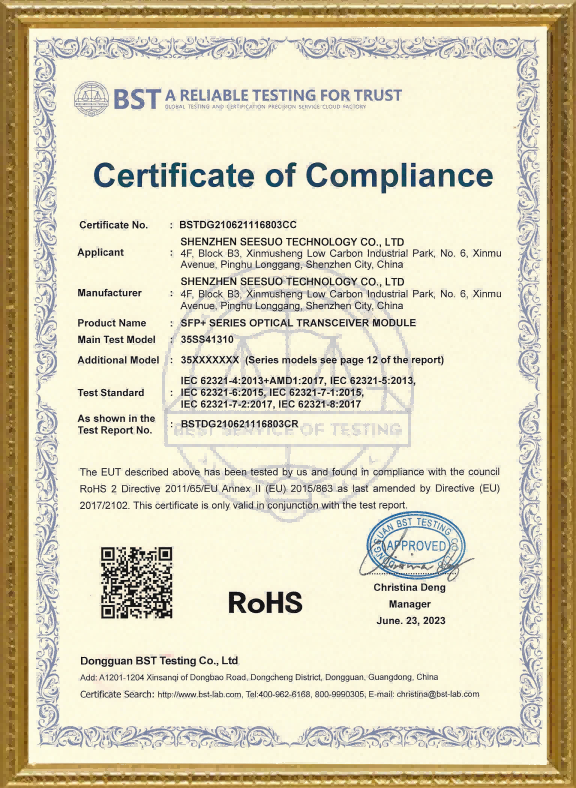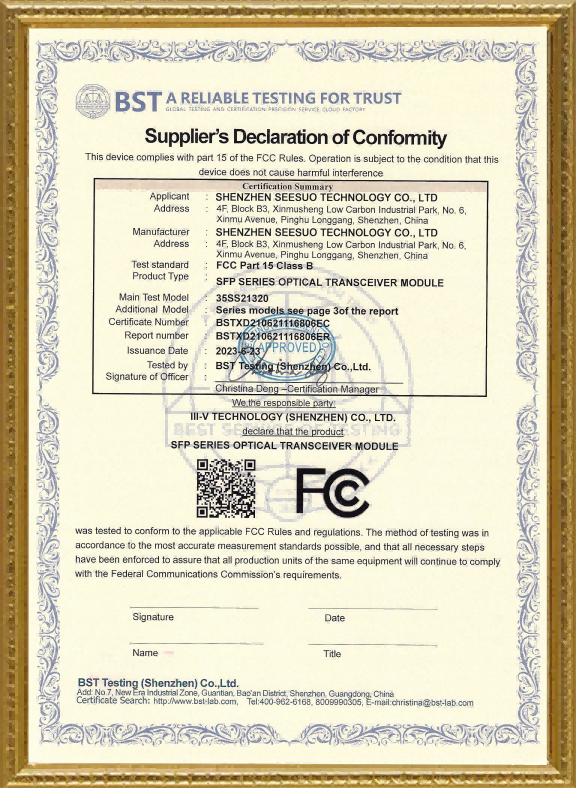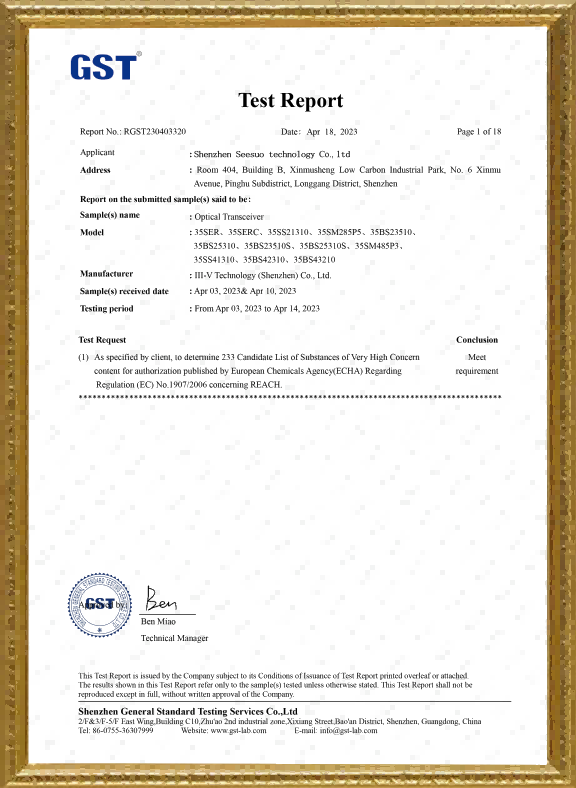Applications:
-
100GBASE-SR4 (MPO-8)
-
100GBASE-LR4 (LC)
-
100GBASE-ER4 (LC)
Quad Small Form Pluggable 28Gbps (QSFP28) Transceiver Modules available with:
-
MPO-8 Fiber QSFP Modules
-
Dual Fiber Strands QSFP+ Modules
Supports various wavelengths such as 850nm, 1310nm , CWDM and distances up to 80km
100G QSFP28: differences and selection of SR4/LR4/PSM4/CWDM4/ER4/ZR4
With the development of 100G Ethernet, the demand for the 100G transceiver market is increasing. At present, 100G transceiver accounts for a large proportion of the cost of network construction. Among these optical modules connecting 100G links, 100G QSFP28 is the first choice because of its small size and low power consumption.
So, what are the types of 100G QSFP28 optical modules? What is the difference between them? How to select these modules? This article will tell you in detail.
What is 100G QSFP28 transceiver?
The 100G QSFP28 optical module is suitable for 100G Ethernet, EDR Infiniband and 32G fibre channel. Generally, its size and panel density are the same as 40G QSFP+. The 40G QSFP+ uses four 10Gbps channels, and the 100G QSFP28 module is similar. Four high-speed differential signal channels are adopted, and the data rate supports 25Gbps, up to 40Gbps. In addition, the 100G QSFP28 has an upgraded electrical interface and can support signals up to 28Gbps. The main types are: QSFP28 SR4, QSFP28 LR4, QSFP28 PSM4, QSFP28 CWDM4 and QSFP28 ER4. Compared with other package types of 100G transceivers (CFP/CFP2/CFP4), the 100G QSFP28has higher density, lower power consumption and obvious price advantages.
100G QSFP28 SR4 vs.LR4 vs. PSM4 vs. CWDM4 vs. ER4 vs. ZR4
After understanding the basic concept of 100G QSFP28, this section will explain in detail the differences of 100G QSFP28 transceiver in terms of standard, laser type, transmission medium and distance.
1. Standards of 100G QSFP28 transceiver
The standard of 100G QSFP28 optical module is mainly defined by IEEE and MSA, in which IEEE defines the standards of QSFP28 SR4, QSFP28 LR4 and QSFP28 ER4. "QSFP" means the packaging(form-factor) of the optical module; "28" indicates that the maximum transmission rate of each channel is 28Gbps; "SR" means short distance (up to 100m), "LR" means long-distance (up to 10km), "ER" means super long-distance (up to 40km); ' "4" means that the module has four channels. For example, QSFP28 LR4 means that the 100G remote module can transmit 100G signals of four wavelengths, and the maximum distance can reach 10km.
As mentioned before, 100Gbase-SR4 and 100Gbase-LR4 are the two most common 100G port specifications defined by IEEE. However, the transmission distance of QSFP28 SR4is too short to meet all connection requirements, and the cost of QSFP28 LR4 for large data centers is too high.
Fortunately, MSA has brought a new solution to the medium distance transmission market: QSFP28 PSM4 and CWDM4 standards have been born. Although QSFP28 LR4 is similar to QSFP28 CWDM4, the CWDM4 transceiver with a transmission distance of 2km is cheaper and more competitive than the LR4 transceiver in terms of cost.
2. Laser types of 100G QSFP28 transceiver
Laser plays an important role in 100G QSFP28 optical module. There are five common lasers: VCSEL, FP, DFB, DML and EML. These different types of lasers have different working wavelengths, working modes and application environments.

VCSEL lasers are characterized by small size, low power consumption, easy integration, low cost, and high coupling efficiency with multimode fibers. This is common in QSFP28 SR4 modules. Since the QSFP2828 LR4 and ER4 modules are used for long-range transmission (10km or 40km), which require lasers with large line-of-sight, low dispersion, high extinction ratio and long transmission distance. The EML lasers can fully meet all these requirements. Then, the DML lasers can achieve signal modulation by modulating the laser's injection current. Because the injection current changes the refractive index of the laser source region, resulting in wavelength drift and dispersion. Therefore, DML is not suitable for long-distance transmission and cannot achieve high-speed signal modulation, but it is suitable for QSFP28 PSM4 and QSFP28 CWDM4 modules with a transmission distance of 500m or 2km.
3. Transmission medium and transmission distance of 100G QSFP28 transceiver
The 100G QSFP28 optical module is equipped with a duplex LC or MTP/MPO-12 connector, and the transmission distance ranges from 70m to 40km. The transmission distance of these optical modules determines their application scenarios—All QSFP28 modules can be used for the direct connection and interconnection of enterprise networks or data centers. The following table details the differences between them.

How to choose 100G QSFP28 transceiver?
After introducing different types of 100G QSFP28 modules, I believe you have a basic understanding of these modules. Next, let's talk about how to select 100G QSFP28 transceiver.
· When the transmission distance is 5m-100m, it is recommended to select the QSFP28 SR4 optical module. The transmission distance of such modules is 70m on OM3 optical fiber and 100m on OM4 optical fiber.
· When the transmission distance is 100m-2km, QSFP28 PSM4 or QSFP28 CWDM4 module can be selected. The unit price of CWDM4 is generally higher than that of PSM4, but CWDM4 only needs two single-mode fibers for bidirectional transmission, while psm4 needs eight. Therefore, the overall cost of using QSFP28 PSM4 may be higher. Therefore, in practical application, you need to consider the specific transmission distance, and then decide which module is appropriate.
· When the transmission distance is 10km-40km, 100G QSFP28 ER4or QSFP28 LR4 can be selected. The former can transmit up to 10km and the latter can transmit up to 40km.
SEESUO QSFP28 SR4 / QSFP28 100G IR4 / 100GBASE-LR4 QSFP28 Optical transceiver modules are designed for use in 100 Gigabit Ethernet links. They are compliant with the QSFP28 MSA and IEEE 802.3 100GBASE and OTU4. as specified by the QSFP28 MSA.An optical fiber ribbon cable with an MTP/MPO connector can be plugged into the QSFP28 SR4/LR4 module receptacle. SEESUO supplies OEM service and Third-Party(Cisco, Juniper, HP, Dell etc.) compatible fiber optic transceivers.
FAQ:
What are the main application scenarios of 100G optical modules?
The primary application of this transceiver is in data centers, Ethernet, and telecommunications settings, serving as a pivotal component for 100G connections within core switches, core routers, and 5G networks.
Would you please explain the FEC (Forward Error Correction)?
FEC (Forward Error Correction) is an error correction method used to identify and rectify a limited number of errors in transmitted data, all without necessitating retransmission. This technique involves appending redundant bits to a bitstream, enhancing the decoder's ability to identify and rectify certain transmission errors, and eliminating the need for retransmission. Activation of this function is dependent on the configuration of the transmission device.
What is the Packaging Technology of the 100g lr4?
BOX Packaging
Product Quality:
Since its inception in 2017, SEESUO has continually refined its processes to assure the best possible quality for our customers. The foundational elements of these processes are Record-Keeping and Quality Assurance Testing (QAT). To maintain a robust data archive, each part is individually serialized both in its internal EEPROM memory and on its external label. All QAT results and other important information (e.g., manufacture date, compatibility programming) are associated with each Serial Number stored in our cloud-based secure database. QAT consists of visual part inspection as well as verification of all critical parameters and performance of each part. For the 100G Dual Fiber QSFP28 transceiver module optical output power and wavelength (850/910nm) are verified on optical spectrum analyzers. Receiver sensitivity is verified at both minimum distance and the 100m maximum range over actual (not simulated) MMF , multimode fiber cable. Digital Diagnostics Monitoring (DDM) parameters including: optical output power, receive optical power, internal module temperature, transmit bias current and supply voltage, are tested for compliance with specifications. In addition, the part is verified for proper operation across its full operating temperature range, 0C to 50C.
Product Highlights:
100G Connectivity for Data Center
Commonly used in data centers to connect Ethernet switches with OM3/OM4 fiber optic cables. SFP+100G transceiver interface has better transmission performance, lower loss and higher pair size.
Tested in Host Devices for Proven Interoperability
QSFP+100G Optical modules are mainly used to realize the connection between network devices in the data center, and are suitable for short-distance transmission.
Supports operation for a data rate of 103.1Gb/s
4x25Gb/s 850mm VCSEL-based transmitter for 100m
4x25Gb/s DFB-based LAN-WDM transmitter for10km~40km
Up to 25Gbps per channel bandwidth
MTP/MPO connector Or Duplex LC connector
Compliant with 100G Ethernet IEEE802.3ae Standard
Compliant with QSFP28 MSA Technical Specifications
Digital Diagnostic Monitoring
Compatible with RoHS
Operating case temperature: Standard: 0 to +70°C
Data centers Switches
Metro networks
100G Ethernet Links
Other optical transmission systems
| Product Model | Rate | Wavelength | Distance | Connector | Cable Type | DDM |
|---|---|---|---|---|---|---|
| SS-QSFP28100G-SR485-L | 100G | 850nm | 100m | MPO | MMF | With DDM |
| SS-QSFP28100G-XX413-L | 100G | 1310nm | 10km,20km,40km | LC | SMF | With DDM |

OEM Manufacturer
SEESUO provides tailored OEM products based on clients' designs and specs.

ODM Manufacturer
SEESUO boastis rich R&D experence and top-notch production management.

Customized production
SEESUO provides talored product design,development, and flexible manufacturing.

R&D cooperation
SEESUO adapts swifly to market changes collaborating with customers in R&D.
What are the key features of the 100G Dual Fiber QSFP28 transceiver?
What types of fiber are compatible with the 100G Dual Fiber QSFP28 module?
What applications benefit from using the 100G Dual Fiber QSFP28 transceiver?
4.9

 Mai ThuyVietnam
Mai ThuyVietnam 4.9Hooked the 100G QSFP28 into my Mellanox SN2700 for a huge speed boost in our data transfers. Incredible performance for big data workloads!
4.9Hooked the 100G QSFP28 into my Mellanox SN2700 for a huge speed boost in our data transfers. Incredible performance for big data workloads!
 Bao MinhVietnam
Bao MinhVietnam 4.8Running this 100G QSFP28 in a Juniper QFX5100. It powers our core network with zero downtime and blazing fast connections. Totally worth the investment!
4.8Running this 100G QSFP28 in a Juniper QFX5100. It powers our core network with zero downtime and blazing fast connections. Totally worth the investment!












































 Online consultation
Online consultation Send email
Send email























